Modern and contemporary artists have frequently used disguise as a performative strategy to reveal critical slippages. Exploring representation of the self as Other opens up new possibilities of identification both politically and aesthetically. The curators of Disguise: Masks and Global African Art , exhibited at the Fowler Museum at the University of California, Los Angeles, conflate disguise—or self-masking to assume a position as Other—with masquerade, which is a shamanistic spiritual tradition in parts of Africa through which the masked performer becomes a vessel of the supernatural. While Disguise raises essential questions about hybrid identity and performativity in contemporary art, this thoughtful and rigorous show suffers from a tendency to distort interpretation of African cultural contexts and traditions by circumscribing them within a Western critical frame.
The exhibition originated at the Seattle Art Museum (SAM), which assembled 24 African-born and diaspora artists to examine the theme of masking in their work. Twelve of the original artists appear in the Fowler exhibition. Central to the exhibition’s conceit is the street masquerade, a traditional procession, with spiritual implications, found throughout Africa and in African-descended communities throughout the Americas. Masquerade appears in numerous West African cultures, including the Ogoni and Igbo, of Nigeria, and the Mende, of Sierra Leone. In Disguise , traditional masks belonging to these cultures have been pulled from the anthropological collections of both museums where the exhibition has been presented and displayed alongside contemporary artists’ works. Masquerade traditions are also manifest in syncretic diaspora cultures, cropping up at Carnival in Brazil, Mardi Gras in New Orleans, and in the Afro-Colombian festival of the Holy Innocents. A pair of Egungun costumes from the Fowler collection set the stage: a jester dubbed “the owner of the mouth that’s in constant celebration” and a mother with child who performs the masquerade’s comic finale. Ethnographic photography shows Egungun in full dress, a state in which they may not be addressed or engaged by ordinary people. Though brightly colored, they are forbidding and alien presences.
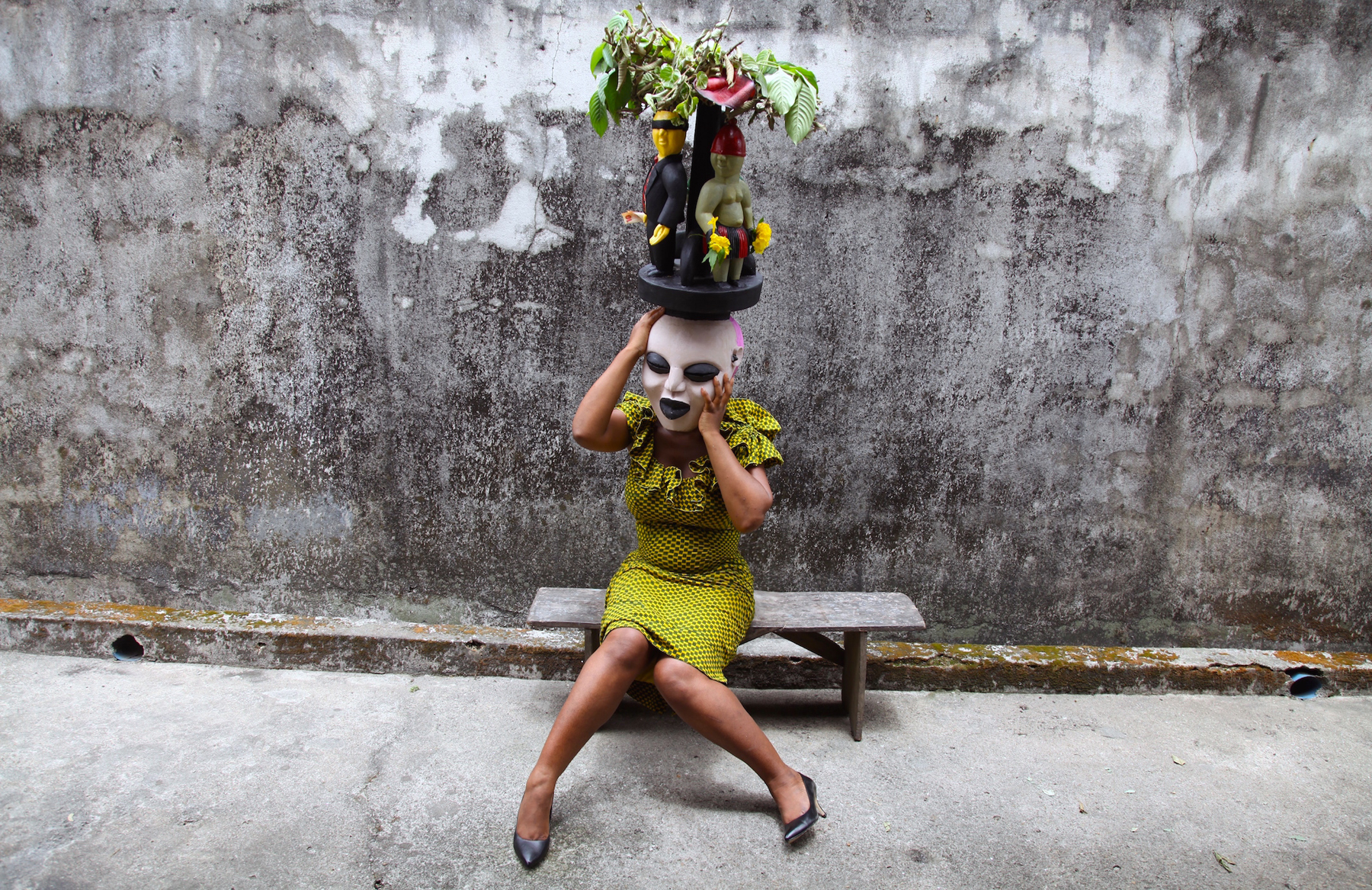
Zina Saro-Wiwa, The Invisible Man, 2015. Exhibition Print, 28 3/4 x 44 inches. Seattle Art Museum, commission, 2015. © Zina Saro-Wiwa. Courtesy the artist.
Despite its placement in an anthropological museum and its use of traditional arts as a foil, Disguise at the Fowler is not a historically minded exhibition. Rather, it is intensely future-oriented. SAM Curator of African and Oceanic Art Pamela McClusky and consulting curator Erika Dalya Massaquoi have included powerful works by important emerging and mid-career artists from the United States, Canada, Britain, South Africa, and Nigeria. The selection of artists underscores the challenge of presenting “global Africa” as a category inclusive of both the continent and its diaspora. These constructs are so broad that each has been necessarily simplified. Africa has a complex relationship to its two largest economies, Nigeria and South Africa, where elites enjoy a quality of life much closer to Western standards than do their poorer countrymen or citizens of many smaller countries on the continent. The diaspora includes not just North American and other Anglophonic cultures, but also extends throughout South America, encompassing the Caribbean’s French and Spanish influences and a history of African migration to southern Europe since medieval times. The contemporary, globally minded artists represented in Disguise work in expanded visual media, including video, photography, animation, installation, and graphic design.
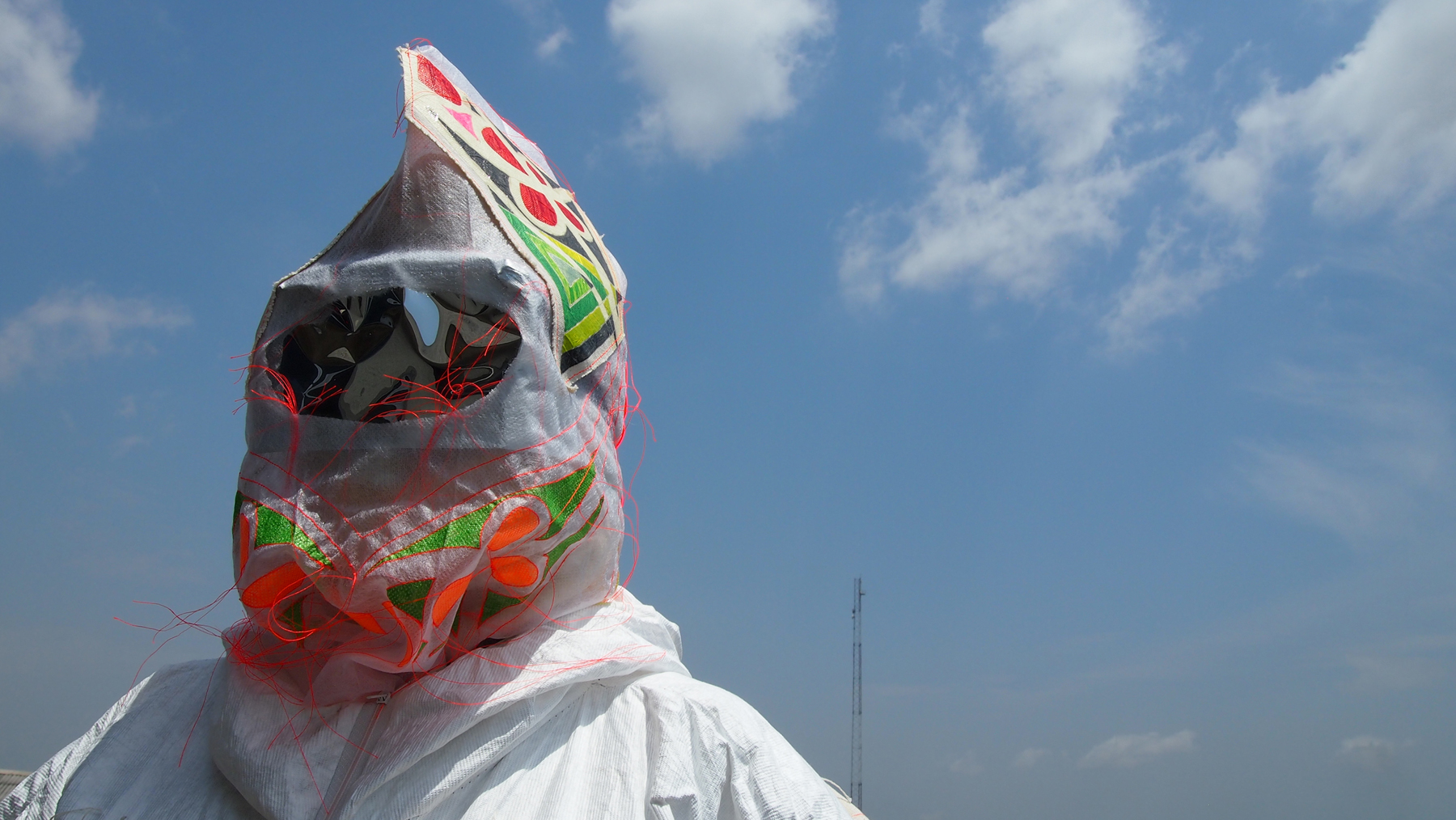
Wura-Natasha Ogunji, An Ancestor Takes a Photograph, 2014. Still from video, Seattle Art Museum, 2015. © Wura-Natasha Ogunji.
The exhibition defines masquerade according to contemporary African rituals, a discussion that is expanded through some of the works by contemporary African artists but treated mainly as a foil by African diaspora artists. Artists familiar with the religious traditions surrounding African masquerade engage with the mask as a fetish object that embodies rather than symbolizes the divine; they seem to invest the mask with spiritual energy and consider the wearing of it as an act of submission to faith. Several are women who challenge the masquerade’s exclusive masculinity. The African-American artists in the exhibition treat the mask symbolically, using it as a symbol of defiance against the surveillance-to-incarceration pipeline of the state or as a metaphor for assimilation and access to white-dominated halls of power. The decision to present multiple cultural paradigms under one thematic umbrella obscures these important distinctions. The artists at the Fowler who work in Africa at least part-time—Nandipha Mntambo, Emeka Ogboh, Wura-Natasha Ogunji, Walter Oltmann, and Zina Saro-Wiwa—are familiar with how masks and masquerade operate within specific African traditions to which they and their audiences are connected and which inspire their contemporary interpretations. The artists who work exclusively outside of Africa—Jakob Dwight, Brendan Fernandes, Sondra R. Perry, Jacolby Satterwhite, Sam Vernon, William Villalongo, and Saya Woolfalk— tend to wrestle more overtly with the history of Western modernism and its appropriation of African forms, using the mask as a means of code-switching between black and white cultural tropes. Though framed around a set of African traditions, the curatorial premise of Disguise is a syncretic, diasporic one, treating hybridity as a presumed fact of contemporary life.
As a critical viewer, one must resist the tendency to impose expectations learned from African-American culture, or stereotypes about tradition equating with authenticity in the developing world, onto works by African artists. Traditional masks in the galleries pose another interpretive challenge, because they were created to operate not as art but as purposeful ritual objects, with religious powers and social functions. The decision to show these two distinct groups of objects alongside works by prominent African-American artists poses a challenge, because the American world view that the curators and audience share can distort the differing intentions of African contemporary artists and traditional artisans to fit our expectations. Many of the artists have been commissioned to create new works for the exhibition that directly engage with African masquerade traditions and objects. Among the African artists, the ritualistic power of the masquerade is generally respected as a religious sacrament, even if its social function is questioned. Among the African-American artists, ritual objects are commoditized and digitized, archived and objectified. To present African ritual masks from multiple cultures as interchangeable forms that contemporary artists have appropriated is to ignore the very different meanings that the traditional objects still hold within their cultures of origin, which should inform our understanding of those cultures’ contemporary artists and artworks. In an interview posted online by SAM, Nigerian sound artist Emeka Ogboh questions what mounting masks on the wall signifies.1 From his cultural position, they are deactivated and cease to function as intended in this unnatural context. In a work commissioned for Disguise, Ogboh attempts to reinvigorate the masks through his installation, in which a soundtrack of ambient sounds gathered from masquerade events injects a necessary performativity into the static space of the museum.
Masquerade remains an important cultural practice throughout Africa, representing a space of spiritual power customarily reserved for men. Zina Saro-Wiwa describes how her initial ethnographic interest became a passion as she realized she could empower the women of the Ogoni tribe, from which the British-born artist descends, through her work with masquerade. Saro-Wiwa’s respect for the spiritual significance of this tradition was such that she did not film and exhibit the all-female masquerade that she organized but instead focused on making visible the women who joined her project and the men who perform the Ogele masquerade. Saro-Wiwa created a sculptural mask representing male abandonment, which she wore and invited local women to wear in her ancestral village in Ogoniland. The women are represented in a slide show of portraits in which they cover their faces with their hands or wear various power objects on their heads. An adjacent series of color photographs shows the artist sitting on a banana leaf, wearing the mask, alongside portraits of the male Ogele performers in their unmasked, post-masquerade state. The men still wear muslin pants and head wraps that fit underneath their elaborate costumes. Through the process of creating her mask and masquerade, which she titled Invisible Man, Saro-Wiwa’s investigation turns from a cultural to an individual point of view.

Nandipha Mntambo, Praça de Touros, 2008. Archival pigment ink on rag paper, edition 71/100, 15 3/4 x 15 3/4 inches. Seattle Art Museum, Gift of Josef Vascovitz and Lisa Goodman, 2014. © Nandipha Mntambo. Photo: iocolor. Courtesy of the Seattle Art Museum.
The protagonist of African-American author Ralph Ellison’s Invisible Man (published in 1952) is wracked with rage at his inability to effect the world around him and how he is perceived within it. He chronicles the anger and conflict that characterize the Black experience, articulating a Western minority consciousness that is separate from but related to the post-colonial politics of late twentieth-century Africa. Saro-Wiwa’s use of the novel’s title and her images of the unmasked Ogele suggest that the Ogoni people, whose post-colonial rediscovery of Ogele masquerade in the 1980s came with strict rules about gendered participation, have suffered an excavation of the self similar to what Ellison described, despite their distance from the traumatic separation of the Middle Passage that characterizes diasporic African experience. Saro-Wiwa’s work becomes a means to heal that trauma, within the village and across the oceans.
Artist Wura-Natasha Ogunji, based in Lagos and Austin, Texas, is more confrontational about flipping the gendered expectations of the masquerade tradition with interventions in public space. She is one of many artists to engage a digital aesthetic in her work. A two-channel video shows the artist and female compatriots walking through a crowded urban landscape in handmade suits that invoke the Egungun masquerade, a traditionally male-enacted ritual in which the masked performer is granted freedom to move anywhere, and none may address him. Like the Egungun, Ogunji and her performers interrupt the daily flow of urban life with the unexpected. The suits—made from white Tyvek, a cheap industrial material known for its durability, and stitched with brightly colored thread in patterns drawn from computer circuitry—are on exhibit as part of Ogunji’s installation at the Fowler. In the video, the suited performers appear as astronauts or exterminators, moving through heavy traffic, shielded against a hostile environment. They suggest ghosts as well—spirits that cannot be fully apprehended. This power to use disguise as a cover to engage in unfettered movement has a parallel in certain Muslim regions where women wear full-body coverings in order to secure their free passage in public space. For women to move through public space in a manner not determined by their physical appearance or conventional social roles can be a radical act.
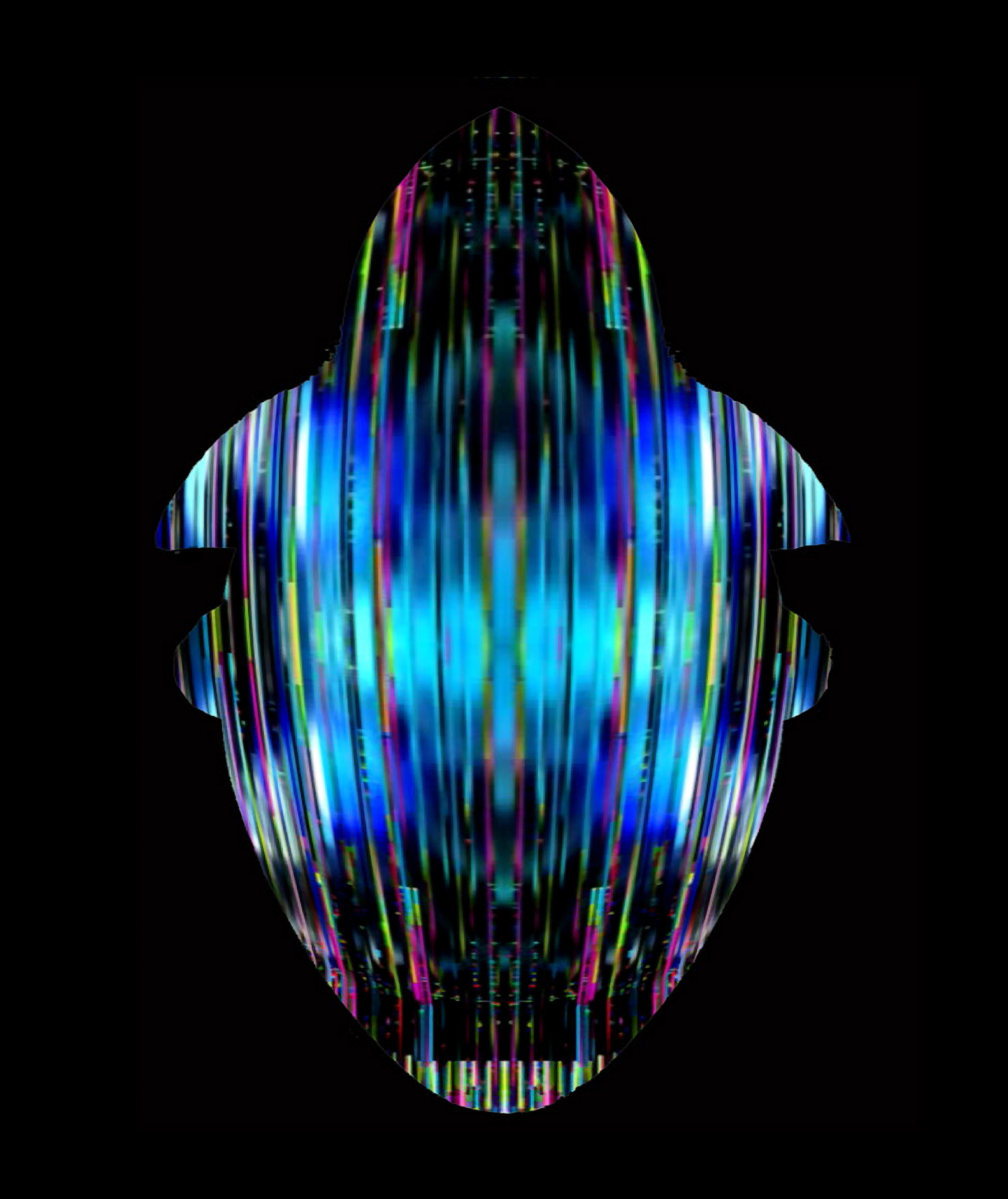
Jakob Dwight, The Autonomous Prism / MSK02, 2010-14. Still from video installation with 16 digital videos, looped in continuous playback; DVD for plasma or projection; 4+ minutes. Seattle Art Museum, commission, 2015. © Jakob Dwight. Courtesy the artist.
Nandipha Mntambo, from South Africa, is also concerned with questions about the value of female beauty and the social norms that surround it. Mntambo works with cross-cultural imagery, such as that of the bullfighter, a masculine archetype imported from Spain that emerged from the battlefields of the Reconquista or purging of North African religious and political influence in the late Middle Ages, and the minotaur, a Greek mythological figure. In her photo series Praça de Touros (2008), she assumes the roles of both bullfighter and bull, thereby problematizing the relationship between the masculine and feminine by applying a dichotomy established in the Baroque period of Western art history. This metaphor is deepened by an understanding of African myths in which humans transform into animals, referencing the shape-shifting aspect of masquerade.
As the bullfighter, Mntambo’s female body creates dissonance within a familiar scene. She uses cowhide to make the bullfighter costume, referencing the symbiosis between predator and prey. Umfelokati Wenhlaba (Widow of the Earth) (2014), is a large wall sculpture made from cowhide that is shaped to the contours of Mntambo’s body. The material wavers between flat and sculptural planes, as the artist fluctuates between male and female, human and animal. Mntambo shifts between two- and three-dimensional works, and between pictorial and object-based approaches to art making. The centerpiece of her contribution to Disguise is Sengifkile (2009), a striking, classical bronze bust of the artist, almond-eyed and stern, with gently twisting horns emerging from her scalp. Using Renaissance conventions of representation, the artist depicts herself at the intersection of human and animal, wedding Western artistic training with African conceptual stakes. Mntambo nods to Picasso in Drawing III and VII (2009), using thick black marks that resemble the Spanish artist’s many etchings and lithographs of bullfighters and minotaurs. In one image, a woman goes nose to nose with the bull; in the other, the bull kneels as if in prayer. Neither features Picasso’s lascivious, bawling brute, which has come to exemplify raw masculinity in the Modernist canon.
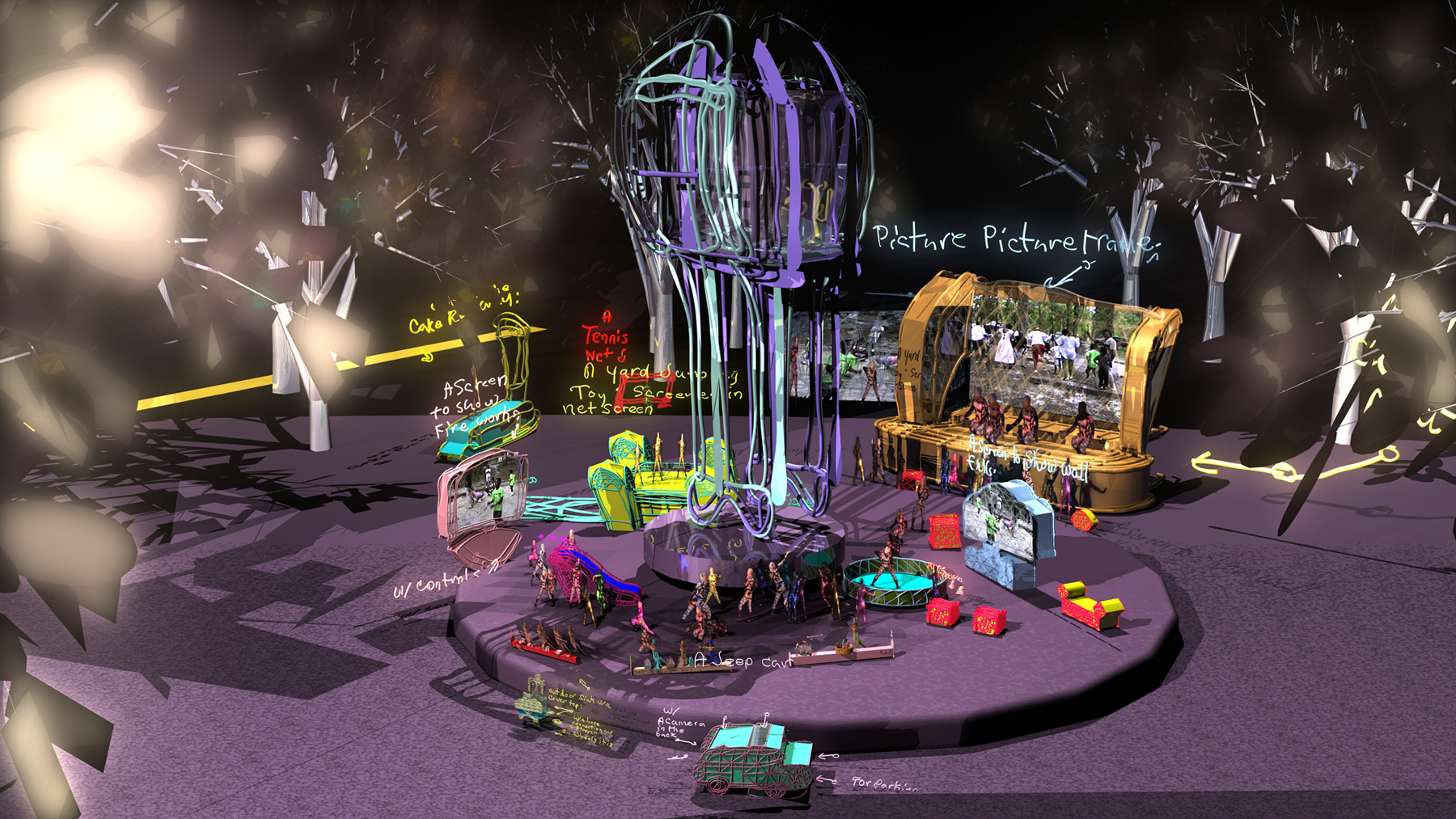
Jacolby Satterwhite, Country Ball, 1989-2012, 2012. HD digital video with color 3-D animation and sound, 12:39 minutes. Seattle Art Museum, Modern Art Acquisition Fund, 2013. © Jacolby Satterwhite. Courtesy Seattle Art Museum.
Mntambo’s interest in combining European and African traditions is rooted in the concept of “third space” postulated by Homi Bhabha, in which binaries of gender, culture, and so on dissolve to reveal an inclusive, hybrid reality. Her use of animal-human shape-shifting synthesizes a South African shamanistic tradition with a trope of Western art history, in which representations of animals, usually livestock or hunted species, such as birds, were integrated into the ornamentation of structural elements in Gothic cathedrals, like pillars and archways. Their load-bearing duties were a physical manifestation of their subjugated roles in an ideal society. Sometimes, the messages would be more overt, such as the depictions of enslaved Africans supporting the bases of pedestals. Later, in the Baroque period, artists began to associate images of animals with femininity, informed by Enlightenment rhetoric that situated women as “closer to nature” (and less intellectually capable) than men. Similar rhetoric was applied to non-white peoples, who were equated with beasts of burden as justification for their displacement and enslavement. Mntambo’s work actively engages these histories. The context created for her work in the exhibition didactics emphasizes the artist’s spiritual transformation through a physical one and her feminist interests as a woman in a male social and religious space. Regrettably, the historical grounding for her inquest into art and history is ignored in this exhibition.
Shape-shifting is a recurring action throughout the exhibition, and whether the shape assumed takes the form of a virtual network or a physical object matters little. New Jersey-born artist Sondra Perry presents the video Double Quadruple Etcetera Etcetera I and II (2013), in which a man and woman dance furiously. The dancers’ heads are visible but their bodies flicker and blur. As the dancers’ digitally manipulated movements mirror and diverge across two video channels, Perry creates the impression that these beings reside in a parallel realm of existence, from which they cross over into our realm only provisionally. She is one of several artists who draw metaphors between the unseen world of digital information and that of the spirits. Watching the dancing figures slip in and out of sight, the viewer has the sense of observing a kind of networked trance.
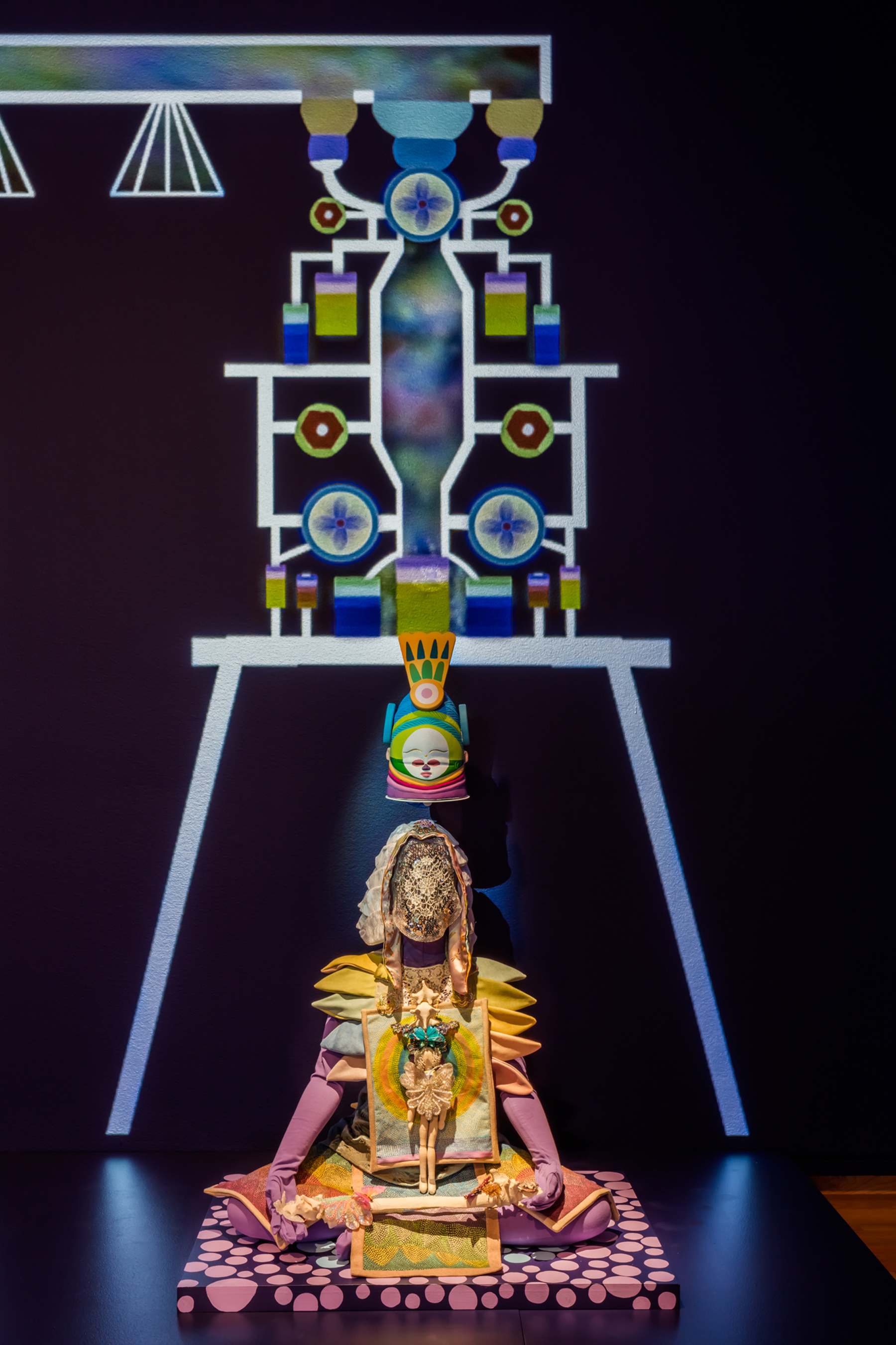
Saya Woolfalk, ChimaTEK: Virtual Chimeric Space (detail), 2015. Installation with five costumes with 3-D masks and video, dimensions variable. Seattle Art Musuem, commission, 2015. © Seattle Art Museum. Photo: Nathaniel Wilson.
In addition to Perry, several other artists in Disguise connect traditional and digital forms, including Jakob Dwight, who uses interruptions or glitches in the flow of information to make digital renderings of African masks mined from the collection of the Seattle Art Museum. The resulting images, animated on a video screen, pulse and ripple in glowing blue. Dwight scrambles the archive with signal noise that corrupts the record, thereby thwarting data’s implicit promise of perfection. His works, which surround and obscure folk art objects with abstract bands of rainbow color, challenge notions of authenticity and historical accuracy. Jacolby Satterwhite puts his technical facility with contemporary modeling and editing programs to the service of a handmade aesthetic reminiscent of early computer graphic imaging of the 1990s. His animations and digital paintings bridge Afrofuturism with Radical Fairies and hacker culture. In his work, shape-shifting and code-switching are linked, and queered. His figures dance in virtual space like digital Egungun, their camouflaged bodies exuberant with free motion. For these artists, distanced from the traditional spiritual implications of masquerade, contemporary new age metaphysics and digital rhetoric become syncretically linked.
Saya Woolfalk and Brendan Fernandes—two artists whose biographies reflect transnational origins across Asia, Africa, and the Americas—use “African” masks in their works that are actually cast from knock-off masks sold amid the fake designer goods on New York’s Canal Street. Using industrial materials, like cast plaster and mold-formed plastic, these artists create gallery-filling installations that position the mask as a permeable barrier, thus representing identity as fluid and changeable. Woolfalk’s ChimaTEK project is a speculative, futuristic makeover that proposes to transform gallery visitors into hybrid beings through masking, allowing them to cross geographic as well as animal-human barriers. In the work, which operates as a proposal for interaction rather than a site of engagement, a video describes the patented ChimaTEK transformation process. Day-glo colors adorn costumes fashioned from a cross-cultural hodgepodge of visual references. An animated backdrop behind costumed mannequins suggests a high-end boutique or costume institute display in which art and commerce intermingle. Periodically, a choreographed performance enacted by two multi-racial dancers activates the gallery, invoking the live theatricality of ritual that transforms African masks from objects into spiritual entities. At other select times, ChimaTEK “agents” offered interpretation of the objects on view to visitors. Woolfalk’s energetic hybrids of form and imagery appeared dynamic and fluid, while a group of Mende masks from Sierra Leone installed on the wall opposite seemed stifled by the stillness of their conventional museum display and interpretation as objects with fixed cultural meanings.
The divide between animal and human is also precarious in Brendan Fernandes’s installation Neo Primitivism 2 (2007–14), which consists of a herd of plastic decoy deer wearing masks amid animated and neon mask forms. Fernandes, who is Kenyan and South Asian, emigrated to Canada and now lives in New York. He grew up in a family that worked in safari tourism, and, as a child, he frequently had to put the decoy deer in place in advance of a group of guests engaged in a mock hunt. In Disguise, the deer become postmodern emblems of entertainment as simulation. They wear Chinatown knock-off plastic fetish masks, which read as a comment on the commodification of identity markers in the post-colonial era. Around the deer, neon masks and flat screen monitors pulsate with the rhythms of Morse code. Their message, which appears as a large text-based wall work, Buli (2011), exclaims: “DON’T SPEAK HIZ NAME/CLASSIFICATION–WOODEN SCULPTURE/COLLECTED IN: AN UNKNOWN PLACE.” The text describes the acts of erasure that occur when museums remove living objects, such as African fetish masks, from the hands of their makers and anticipated users, and subjugate the autonomy of these objects to the visual consumption and ideological self-affirmation of a Western museum-going audience.
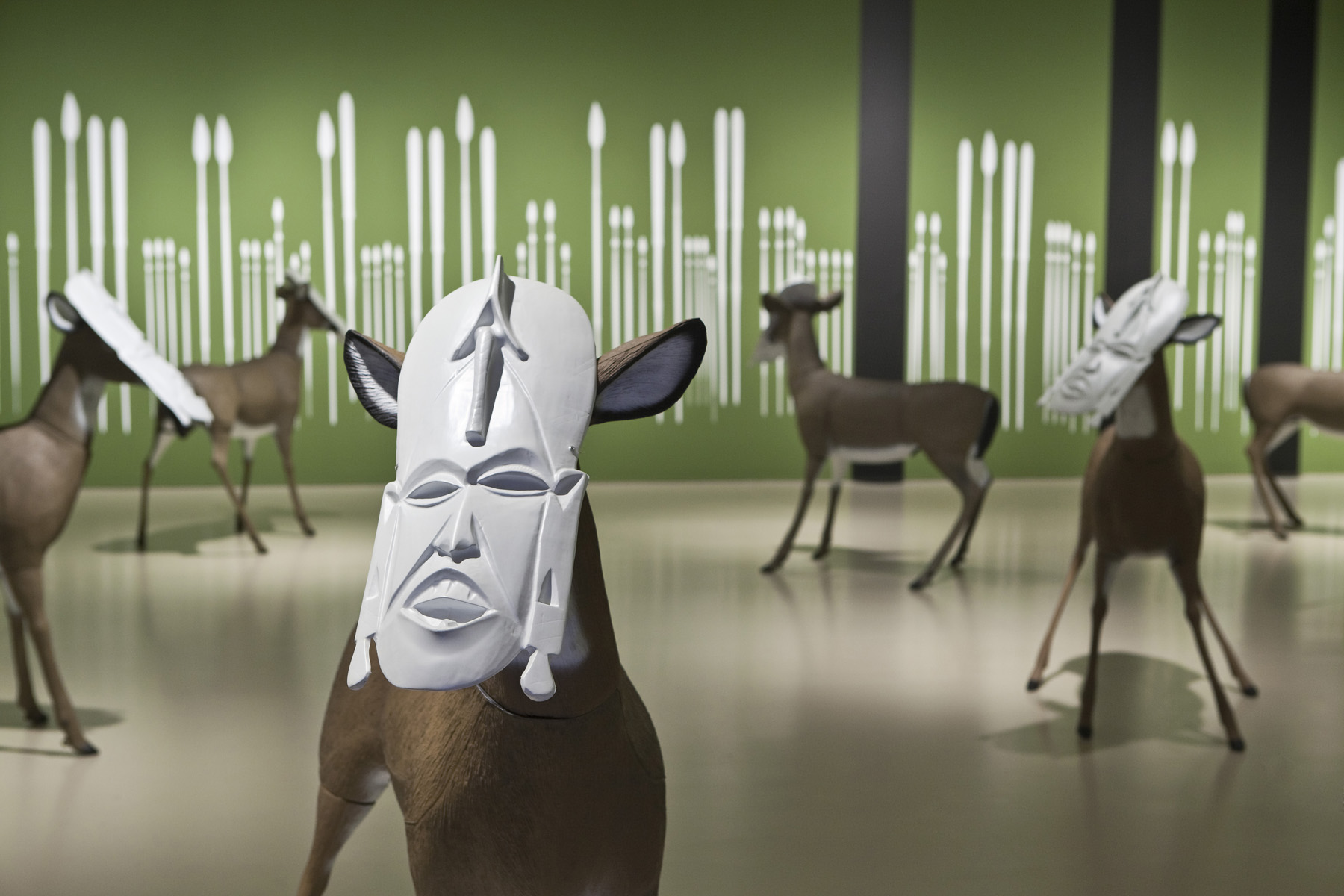
Brendan Fernandes, Neo Primitivism 2, 2007-14. Installation with plastic masks, deer decoys, and vinyl spears: dimensions variable. © Brendan Fernandes. Courtesy the artist.
The patois of Fernandes’s text is a gesture toward créolité, a Caribbean discourse of hybridity that emerged through the work of writers such as Homi Bhabha and Edouard Glissant in contrast to the Afrocentric doctrine of négritude in the mid-twentieth century. Fernandes’s use of the mask as a facsimile or facade concealing a “real” self (the decoy deer) that is in fact another hollow fake invokes Bhabha’s discussion of mimicry as an assimilation tactic masking a profoundly inauthentic inner self. In the twenty-first century, the politics of identity are still evolving from embodying essentialist values to adopting hybrid cultural ones. Bhabha’s characterization of assimilation as cultural violence builds on Frantz Fanon’s critique in Black Skin, White Masks (first published in 1952), but also splits with this position. Behind the mimic’s white mask is Ellison’s invisible man, expressing raw rage at his own lack of presence and the cruel trade-off of his cultural amputation. Fanon articulates this anger and conflicted desire with a precision that reflects his training as a psychiatrist, and at the same time contradicts that profession’s perceived neutrality. Informed by Lacanian theories of identity construction as well as by the négritude movement, which was popularized by his teacher, Aime Cesaire, and Senegalese leader Leopold Senghor, Fanon describes the process by which “Frenchness” is conferred on persons of African origin in Martinique through both selective interbreeding between blacks and whites, which produces lighter skin tones, and the adoption of French cultural and class expectations. Privilege, expressed as Frenchness or Whiteness, takes the symbolic form of a mask concealing the abject face beneath. When confronted with the Black man that he has denied and Othered, the assimilated Martinican denies his recognition. Speaking from the Martinican’s position, Fanon asserts, “I do not try to be naked in the sight of the object. The object is denied in terms of individuality and liberty. The object is an instrument. It should enable me to realize my subjective security.”2 Fanon’s essentialist view of race relations frames dilution of Blackness as a betrayal, perpetuated mainly by Black women seeking to relieve their double burden of oppression by appropriating Whiteness at the expense of Black men. His inheritors, including Bhabha and Glissant, as well as the curators and artists of Disguise, are more accepting of the racial dilution of créolité as an inevitable and potentially productive condition of our interconnected, intersectional global paradigm—one in which the Creole allows recognition of Blackness as one equal lineage among others.
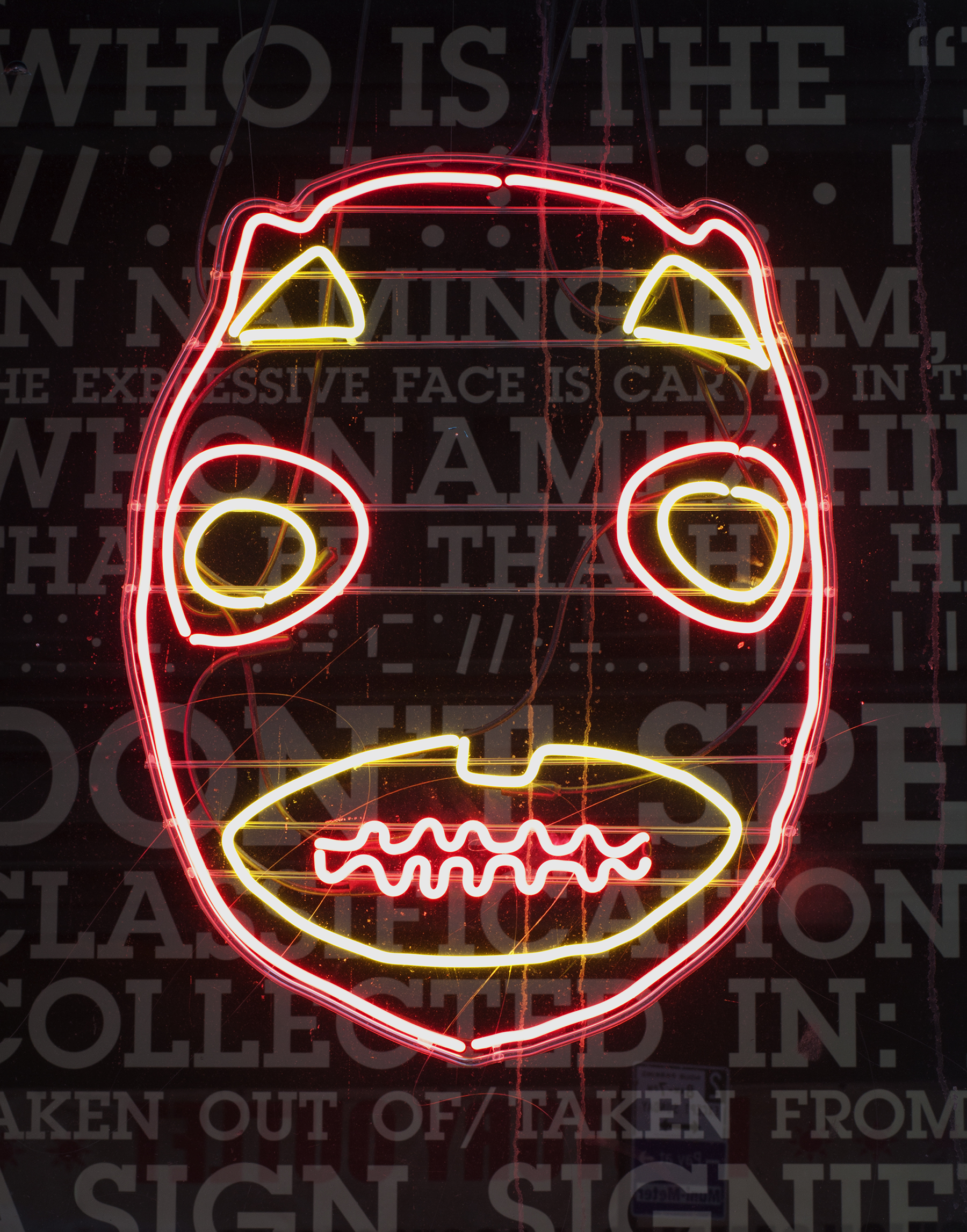
Brendan Fernandes, From Hiz Hands, 2010. Three neon-on-glass-frame signs. © Brendan Fernandes. Courtesy the artist.
Disguise represents a great leap forward for museums embracing discussions of hybridity and digital cultures in the developing world. For that reason alone, it is an important exhibition. The show presents several of the most interesting emerging African artists currently working and a number of notable artists from the Anglophone diaspora in the United States, Britain, and Canada. The representation of time-based and digital media is strong and timely. At the same time, Disguise is very much an African-American exhibition, and the African-American paradigm in 2016 remains limited in its engagement with Africa beyond romantic and primitive ideas rooted in colonial rhetoric. The intentions of the African artists included are difficult to clearly identify, between the historical baggage of ethnographic collections, on one hand, and Diaspora artists’ nonstop shape-shifting on the other.
Anuradha Vikram is a writer, curator, faculty member at Otis College of Art and Design, and Director of Residency Programs at 8th Street Arts Center in Santa Monica, California. Her research focus is transnational futurism, combining media studies, theory of globalization, and critical race discourse with modern and contemporary art history.
